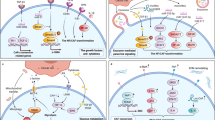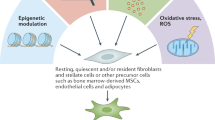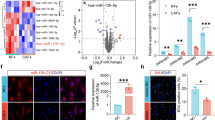Abstract
Tumors are complex ecosystems composed of networks of interacting 'normal' and malignant cells. It is well recognized that cytokine-mediated cross-talk between normal stromal cells, including cancer-associated fibroblasts (CAFs), vascular endothelial cells, immune cells, and cancer cells, influences all aspects of tumor biology1. Here we demonstrate that the cross-talk between CAFs and cancer cells leads to enhanced growth of oncolytic virus (OV)-based therapeutics. Transforming growth factor-β (TGF-β) produced by tumor cells reprogrammed CAFs, dampened their steady-state level of antiviral transcripts and rendered them sensitive to virus infection. In turn, CAFs produced high levels of fibroblast growth factor 2 (FGF2), initiating a signaling cascade in cancer cells that reduced retinoic acid-inducible gene I (RIG-I) expression and impeded the ability of malignant cells to detect and respond to virus. In xenografts derived from individuals with pancreatic cancer, the expression of FGF2 correlated with the susceptibility of the cancer cells to OV infection, and local application of FGF2 to resistant tumor samples sensitized them to virotherapy both in vitro and in vivo. An OV engineered to express FGF2 was safe in tumor-bearing mice, showed improved therapeutic efficacy compared to parental virus and merits consideration for clinical testing.
This is a preview of subscription content, access via your institution
Access options
Subscribe to this journal
Receive 12 print issues and online access
209,00 € per year
only 17,42 € per issue
Buy this article
- Purchase on SpringerLink
- Instant access to full article PDF
Prices may be subject to local taxes which are calculated during checkout




Similar content being viewed by others
Accession codes
References
Hanahan, D. & Coussens, L.M. Accessories to the crime: functions of cells recruited to the tumor microenvironment. Cancer Cell 21, 309–322 (2012).
Chung, A.S. et al. An interleukin-17–mediated paracrine network promotes tumor resistance to anti-angiogenic therapy. Nat. Med. 19, 1114–1123 (2013).
Hwang, R.F. et al. Cancer-associated stromal fibroblasts promote pancreatic tumor progression. Cancer Res. 68, 918–926 (2008).
Lisanti, M.P., Martinez-Outschoorn, U.E. & Sotgia, F. Oncogenes induce the cancer-associated fibroblast phenotype: Metabolic symbiosis and “fibroblast addiction” are new therapeutic targets for drug discovery. Cell Cycle 12, 2723–2732 (2013).
Nakasone, E.S. et al. Imaging tumor-stroma interactions during chemotherapy reveals contributions of the microenvironment to resistance. Cancer Cell 21, 488–503 (2012).
Straussman, R. et al. Tumour micro-environment elicits innate resistance to RAF inhibitors through HGF secretion. Nature 487, 500–504 (2012).
Sun, Y. et al. Treatment-induced damage to the tumor microenvironment promotes prostate cancer therapy resistance through WNT16B. Nat. Med. 18, 1359–1368 (2012).
Wilson, T.R. et al. Widespread potential for growth-factor-driven resistance to anticancer kinase inhibitors. Nature 487, 505–509 (2012).
Breitbach, C.J. et al. Intravenous delivery of a multi-mechanistic cancer-targeted oncolytic poxvirus in humans. Nature 477, 99–102 (2011).
Heo, J. et al. Randomized dose-finding clinical trial of oncolytic immunotherapeutic vaccinia JX-594 in liver cancer. Nat. Med. 19, 329–336 (2013).
Kalluri, R. & Zeisberg, M. Fibroblasts in cancer. Nat. Rev. Cancer 6, 392–401 (2006).
Löhr, M. et al. Transforming growth factor-β1 induces desmoplasia in an experimental model of human pancreatic carcinoma. Cancer Res. 61, 550–555 (2001).
Rønnov-Jessen, L. & Petersen, O.W. Induction of αα-smooth muscle actin by transforming growth factor-β1 in quiescent human breast gland fibroblasts. Implications for myofibroblast generation in breast neoplasia. Lab. Invest. 68, 696–707 (1993).
Sobol, P.T. et al. Adaptive antiviral immunity is a determinant of the therapeutic success of oncolytic virotherapy. Mol. Ther. 19, 335–344 (2011).
Stojdl, D.F. et al. VSV strains with defects in their ability to shutdown innate immunity are potent systemic anti-cancer agents. Cancer Cell 4, 263–275 (2003).
Brun, J. et al. Identification of genetically modified Maraba virus as an oncolytic rhabdovirus. Mol. Ther. 18, 1440–1449 (2010).
Azzarone, B. et al. Abnormal properties of skin fibroblasts from patients with breast cancer. Int. J. Cancer. 33, 759–764 (1984).
Brouty-Boyé, D. et al. Fetal myofibroblast-like cells isolated from post-radiation fibrosis in human breast cancer. Int. J. Cancer. 47, 697–702 (1991).
Schor, S.L., Schor, A.M. & Rushton, G. Fibroblasts from cancer patients display a mixture of both foetal and adult-like phenotypic characteristics. J. Cell Sci. 90, 401–407 (1988).
Cirri, P. & Chiarugi, P. Cancer associated fibroblasts: the dark side of the coin. Am. J. Cancer Res. 1, 482–497 (2011).
Erez, N., Truitt, M., Olson, P., Arron, S.T. & Hanahan, D. Cancer-associated fibroblasts are activated in incipient neoplasia to orchestrate tumor-promoting inflammation in an NF-κB–dependent manner. Cancer Cell 17, 135–147 (2010).
Franco, O.E., Shaw, A.K., Strand, D.W. & Hayward, S.W. Cancer associated fibroblasts in cancer pathogenesis. Semin. Cell Dev. Biol. 21, 33–39 (2010).
Orimo, A. et al. Stromal fibroblasts present in invasive human breast carcinomas promote tumor growth and angiogenesis through elevated SDF-1/CXCL12 secretion. Cell 121, 335–348 (2005).
Räsänen, K. & Vaheri, A. Activation of fibroblasts in cancer stroma. Exp. Cell Res. 316, 2713–2722 (2010).
Spaeth, E.L. et al. Mesenchymal stem cell transition to tumor-associated fibroblasts contributes to fibrovascular network expansion and tumor progression. PLoS ONE 4, e4992 (2009).
Ablasser, A. et al. RIG-I-dependent sensing of poly(dA:dT) through the induction of an RNA polymerase III––transcribed RNA intermediate. Nat. Immunol. 10, 1065–1072 (2009).
Chiu, Y.H., Macmillan, J.B. & Chen, Z.J. RNA polymerase III detects cytosolic DNA and induces type I interferons through the RIG-I pathway. Cell 138, 576–591 (2009).
Yoneyama, M. et al. The RNA helicase RIG-I has an essential function in double-stranded RNA-induced innate antiviral responses. Nat. Immunol. 5, 730–737 (2004).
Altomonte, J. & Ebert, O. Sorting out Pandora's box: discerning the dynamic roles of liver microenvironment in oncolytic virus therapy for hepatocellular carcinoma. Front. Oncol. 4, 85 (2014).
Kurozumi, K. et al. Effect of tumor microenvironment modulation on the efficacy of oncolytic virus therapy. J. Natl. Cancer Inst. 99, 1768–1781 (2007).
Stanford, M.M., Breitbach, C.J., Bell, J.C. & McFadden, G. Innate immunity, tumor microenvironment and oncolytic virus therapy: friends or foes? Curr. Opin. Mol. Ther. 10, 32–37 (2008).
Kim, R., Emi, M. & Tanabe, K. Cancer immunoediting from immune surveillance to immune escape. Immunology 121, 1–14 (2007).
Lichty, B.D., Breitbach, C.J., Stojdl, D.F. & Bell, J.C. Going viral with cancer immunotherapy. Nat. Rev. Cancer 14, 559–567 (2014).
Erkan, M. et al. The role of stroma in pancreatic cancer: diagnostic and therapeutic implications. Nat Rev Gastroenterol. Hepatol. 9, 454–467 (2012).
Erkan, M. et al. The impact of the activated stroma on pancreatic ductal adenocarcinoma biology and therapy resistance. Curr. Mol. Med. 12, 288–303 (2012).
Sanfilippo, C.M. & Blaho, J.A. ICP0 gene expression is a herpes simplex virus type 1 apoptotic trigger. J. Virol. 80, 6810–6821 (2006).
Dayer, A.G. et al. Expression of FGF-2 in neural progenitor cells enhances their potential for cellular brain repair in the rodent cortex. Brain 130, 2962–2976 (2007).
Kim, J.H. et al. Systemic armed oncolytic and immunologic therapy for cancer with JX-594, a targeted poxvirus expressing GM-CSF. Mol. Ther. 14, 361–370 (2006).
Breitbach, C.J. et al. Targeting tumor vasculature with an oncolytic virus. Mol. Ther. 19, 886–894 (2011).
Emig, D. et al. AltAnalyze and DomainGraph: analyzing and visualizing exon expression data. Nucleic Acids Res. 38, W755–W762 (2010).
Eden, E., Navon, R., Steinfeld, I., Lipson, D. & Yakhini, Z. GOrilla: a tool for discovery and visualization of enriched GO terms in ranked gene lists. BMC Bioinformatics 10, 48 (2009).
Samarajiwa, S.A., Forster, S., Auchettl, K. & Hertzog, P.J. INTERFEROME: the database of interferon regulated genes. Nucleic Acids Res. 37, D852–D857 (2009).
Pfaffl, M.W. A new mathematical model for relative quantification in real-time RT-PCR. Nucleic Acids Res. 29, e45 (2001).
Östman, A. & Augsten, M. Cancer-associated fibroblasts and tumor growth–bystanders turning into key players. Curr. Opin. Genet. Dev. 19, 67–73 (2009).
Tomayko, M.M. & Reynolds, C.P. Determination of subcutaneous tumor size in athymic (nude) mice. Cancer Chemother. Pharmacol. 24, 148–154 (1989).
Dell, R.B., Holleran, S. & Ramakrishnan, R. Sample size determination. ILAR J 43, 207–213 (2002).
Acknowledgements
This work was funded by grants from the Terry Fox Research Foundation (201201TFF-271514-TFF-AYDP-29782) and the Canadian Institutes of Health Research (314043) to J.C.B., J.-S.D., D.F.S., B.D.L. and R.C.A. C.S.I. is the recipient of a Fellowship award from the Alberta Innovative Health Solutions. J.C.B., D.F.S. and B.D.L. are supported by the Ontario Institute for Cancer Research and the Ottawa Regional Cancer Foundation. M.M. is funded by the Canadian Institutes of Health Research Frederick Banting and Charles Best Master's Award. C.B. is funded by the Natural Sciences and Engineering Research Council of Canada. We thank C. Cemeus and D. Vaillant for their exceptional technical support as well as members of the Bell, Auer, Atkins and Diallo laboratories for feedback on this project. pWPI-spbFGF plasmid was a gift from J. Kiss and P. Salmon (University of Geneva Medical School). HSV-1 N212 expressing GFP14,36 was a gift from K. Mossman (McMaster University). Reovirus was a gift from P. Lee (Dalhousie University). Rabbit anti-reovirus T3 antibody was a gift from E. Brown (University of Ottawa).
Author information
Authors and Affiliations
Contributions
C.S.I., M.M., C.B., D.B.N., S.C., F.L.B., S.H.T., J.M., M. Boileau, D.B., L.S., P.S., H.L.A. and V.A.J. conducted in vitro experiments. C.S.I., M.M., T.F., C.T.d.S. and D.B.N. performed mouse experiments. P.P. and A.C. recruited individuals with pancreatic cancer and collected biopsies from subjects with pancreatic cancer. R.M.S., M. Burdick and A.C. isolated normal and cancer-associated fibroblasts. A.A., J.Z. and R.C.A. engineered the MG1-FGF2 virus. C.S.I., M.M., C.B., A.A., C.L.A., D.F.S., J.-S.D., B.D.L. and J.C.B. designed the study and were involved in writing of the manuscript.
Corresponding author
Ethics declarations
Competing interests
The authors declare no competing financial interests.
Supplementary information
Supplementary Text and Figures
Supplementary Figures 1–15 and Supplementary Table 1 (PDF 21948 kb)
Rights and permissions
About this article
Cite this article
Ilkow, C., Marguerie, M., Batenchuk, C. et al. Reciprocal cellular cross-talk within the tumor microenvironment promotes oncolytic virus activity. Nat Med 21, 530–536 (2015). https://doi.org/10.1038/nm.3848
Received:
Accepted:
Published:
Issue Date:
DOI: https://doi.org/10.1038/nm.3848
This article is cited by
-
Oncolytic virotherapy evolved into the fourth generation as tumor immunotherapy
Journal of Translational Medicine (2023)
-
Modifying oncolytic virotherapy to overcome the barrier of the hypoxic tumor microenvironment. Where do we stand?
Cancer Cell International (2022)
-
Combination therapy with CAR T cells and oncolytic viruses: a new era in cancer immunotherapy
Cancer Gene Therapy (2022)
-
Clinicopathological and prognostic value of lysyl oxidase expression in gastric cancer: a systematic review, meta-analysis and bioinformatic analysis
Scientific Reports (2022)
-
Gastrointestinal cancer-associated fibroblasts expressing Junctional Adhesion Molecule-A are amenable to infection by oncolytic reovirus
Cancer Gene Therapy (2022)



